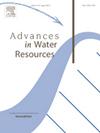Effect of an interface undulation on convective dissolution of CO2
IF 4
2区 环境科学与生态学
Q1 WATER RESOURCES
引用次数: 0
Abstract
When a partially miscible fluid dissolves into a host phase below it, buoyancy-driven fingering develops when the diffusive boundary solution created is denser than the underlying solvent. In many situations, the interface between the two fluids may present level variations introduced by geometrical irregularities. We study here numerically the influence of this interface undulation on the properties of the convective dissolution and on the resulting transfer flux. Two-dimensional time dependent numerical simulations are performed, assuming that the flow is governed by Darcy’s law, along with the Boussinesq approximation, to account for buoyancy effects introduced by a concentration dependent density. The velocity field is modeled by a vorticity–stream function formulation. The resulting equations are solved through the Taylor–Galerkin Finite Element Method, using a Crank–Nicolson time discretization. It is observed that the onset of the fingering instability is delayed in the inclined regions between the peaks and valleys of the undulation and that the fingers develop mainly in the horizontal regions. Additionally, at the valleys, there is an accumulation of the solute and a thickening of the boundary layer caused by the recirculation which induces the nucleation and by the anchoring of the fingering process at that location. This anchoring is maintained up to the later shutdown stages for cases with large interface undulations. While the flux is larger during the diffusive and initial fingering stages, the asymptotic flux is not strongly influenced by the undulation.
界面波动对CO2对流溶解的影响
当部分可混溶的流体溶解到其下的宿主相中时,当产生的扩散边界溶液的密度大于底层溶剂时,浮力驱动的指动就会发生。在许多情况下,两种流体之间的界面可能呈现由几何不规则性引起的水平变化。本文用数值方法研究了这种界面波动对对流溶解性质和由此产生的传递通量的影响。二维时间相关的数值模拟进行了,假设流动是由达西定律和Boussinesq近似控制的,以解释由浓度相关密度引入的浮力效应。速度场采用涡流函数模型。所得方程通过Taylor-Galerkin有限元法求解,采用Crank-Nicolson时间离散化。可以观察到,指法不稳定性的发生在波动峰谷之间的倾斜区域延迟,手指主要在水平区域发育。此外,在山谷处,由于诱导成核的再循环和指进过程在该位置的锚定,存在溶质的积累和边界层的增厚。对于界面波动较大的情况,这种锚定一直保持到后期关井阶段。在扩散和指法初始阶段,通量较大,但渐近通量受波动的影响不大。
本文章由计算机程序翻译,如有差异,请以英文原文为准。
求助全文
约1分钟内获得全文
求助全文
来源期刊

Advances in Water Resources
环境科学-水资源
CiteScore
9.40
自引率
6.40%
发文量
171
审稿时长
36 days
期刊介绍:
Advances in Water Resources provides a forum for the presentation of fundamental scientific advances in the understanding of water resources systems. The scope of Advances in Water Resources includes any combination of theoretical, computational, and experimental approaches used to advance fundamental understanding of surface or subsurface water resources systems or the interaction of these systems with the atmosphere, geosphere, biosphere, and human societies. Manuscripts involving case studies that do not attempt to reach broader conclusions, research on engineering design, applied hydraulics, or water quality and treatment, as well as applications of existing knowledge that do not advance fundamental understanding of hydrological processes, are not appropriate for Advances in Water Resources.
Examples of appropriate topical areas that will be considered include the following:
• Surface and subsurface hydrology
• Hydrometeorology
• Environmental fluid dynamics
• Ecohydrology and ecohydrodynamics
• Multiphase transport phenomena in porous media
• Fluid flow and species transport and reaction processes
 求助内容:
求助内容: 应助结果提醒方式:
应助结果提醒方式:


